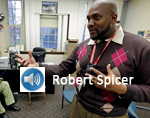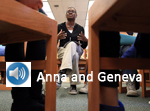
September 3, 2013
by Barbara Cervone
In September 2009, Chicago’s Fenger High School became a poster child for urban school violence when rival gangs from the school beat to death an honors student on his way home. Four years later, the school is making news again: as a turnaround school, where staff do everything in their power to build a community of supports where failure is not an option. A vibrant restorative justice program has been integral to this transformation. This article is part of a larger WKCD case study that documents how Fenger weaves social and emotional learning into daily practice.
CHICAGO, IL —The stresses of being a teen in one of the Chicago’s most violent neighborhoods don’t trigger the metal detectors at the entrance to Fenger High School on the city’s South Side. But they erupt daily in the classrooms and halls of this “turnaround” school, where small transformations separate hope from heartbreak.
Soft-spoken but tough, Shoshanna thought her teacher in senior English class was disrespecting her. She had called out to her teacher, who was helping some other students, but the teacher didn’t respond. Maybe it was because Shoshanna hadn’t raised her hand, like she was supposed to, or because her low-speaking voice was impossible to hear over the classroom din.
Shoshanna got mad, got up, and walked toward the door. “What's going on?” the teacher asked.
“I been trying to call you. I need you to come here!” Shoshanna shot back.
|
“Whoa. Come on. Step outside,” the teacher said. Shoshanna complied, but she had already reached a 10 on the anger scale, and nothing the teacher said could stop her from feeling wronged. Her shouting soon drew a nearby security guard—at Fenger security receives special training in de-escalating students—but Shoshanna was on fire. She dropped the F-bomb and landed in the dean’s office.
When the dean asked, “What's up?,” Shoshanna looked down, fell silent, then explained that she was pregnant and had a lot on her mind. In a school where zero tolerance policies ruled, Shoshanna would probably have been suspended, regardless of what had shortened her fuse. At Fenger, the dean decided this was a matter best resolved through peer jury, which has become part of the school’s nerve center.
Within an hour Shoshanna, two of her peers, and her teacher were sitting down and sorting out what had happened and how Shoshanna could have handled matters differently (including raising her hand). Hard feelings eased, the group helped Shoshanna master the skill of making a genuine apology, a step she was now eager to take and did. Fifty-two days shy of graduation, Shoshanna had regained her place in the commencement line and learned a few lessons in what Fenger’s peer jurors call “positivity.”
For Robert Spicer, who oversees the school’s unique blend of peer jury, peace circles, and supportive listening, Shoshanna’s recalibration was all part of a day’s work. From the start of school through late afternoon, his room, nicknamed the “peace room,” is where disagreements and harm spill out and heal.
When Robert Spicer became the school’s first Culture and Climate Coordinator in 2010, he had already developed an abiding interest in the practice of restorative justice. For six years he had worked with Chicago’s Community Justice for Youth Institute, managing a program that resolved youth crime and conflict through community panels instead of juvenile court. He had also become part of a movement among community-based organizations in the city to provide alternatives to zero tolerance, which by all accounts was pushing more black and brown students towards jail than college.
Fenger High School’s new principal, Elizabeth Dozier, invited Spicer to build a program that put creative conflict resolution at the heart of the school’s culture. For Spicer that included adapting the indigenous ritual of peace circles.
Our principal [gave me] the license to design and craft, to make mistakes and evolve. There’s no cookie cutter to this. I believed that if we built something powerful, the students would come. At first they were like, “What is this kooky stuff you’re doing? What is this? Voodoo? You lighting a candle? Awww. I ain’t…you try'na what? You try'na do what? Naw!” They felt very uncomfortable. Now, kids are asking for peace circles all the time, with their teachers, their friends, their enemies, their parents. We’ve had 20 people fill a circle in this room. It’s become a sacred space, where young people can speak, share, and be heard, where they can learn how to disagree with someone and still be their friend.
Peer jury, the mediation that soothed Shoshanna, became another antidote. “Every issue is different, and just like a doctor, when the patient comes in, you ask them, ‘What's hurting you?’” Spicer says. “In my case, it's the emotional area. I ask a series of questions, and then I determine whether it's a peace circle or a peer jury or a family conference.” Whatever the decision, participation is voluntary.
At Fenger High School, as in schools nationwide that have embraced peer juries as a tool in restorative justice, a student who has broken a school rule sits in a circle with trained student jurors. Together they discuss why the incident occurred, who was affected, and how the referred student can repair the harm caused. The student signs a contract that spells out specific action steps and agrees to allow one of the peer jurors to monitor his or her success. The proceedings are confidential unless students speak of harming themselves or others.
Geneva, a peer juror and a senior, explains:
Kids come into this peace room and we try to repair the harm that was done. It may be something huge, it may be something small. You talk to them, you ask them how can we fix the situation and the harm that was committed. You try to find common ground between two people or just the person in general, to help them get back on track or to act peacefully towards another student.
Peer jury also involves building the community “that’s supposed to be,” adds Anna. "It’s about building trust among students and with teachers, about helping the teachers understand us—and our understanding ourselves—and then having a relationship that helps both of us."
As peers, of course, Geneva and Anna walk in their classmates’ shoes. Since they are going through the same things that their peers are going through, trust flows more naturally. Students often approach them in the hall, they note, with a question or a concern, which they do their best to address. “It’s part of our job, it’s like we’re peace ambassadors,” says Geneva. “If something is amiss in the school, if something isn’t going right, then we should be the ones to be able to fix it. . . . maybe not fix it, but help make the situation better.”
Spicer says he is always asked how the school makes the time for so much peace building (a question he finds ironic). Are kids pulled out of class? Does it happen mostly at lunch or after school? Put simply, Spicer says, “It happens whenever it needs to happen. At Fenger, it’s a top priority.” Indeed, Principal Dozier sets a weekly benchmark for how many student infractions that go to the dean receive, in turn, a restorative response; the floor is 40 percent.
The goal is to arrange a peer jury or peace circle as soon as the parties are available. If need be, a participant may be pulled from class. “We believe that once the issue is taken care of, the young person can go back to class and be focused,” says Spicer.
It doesn't make sense to say, “Okay, well we can only do it this time and only be this amount of time and all.” We don't put a time limit on it. What's important is to make sure the young people understand that we'll take whatever time we need to ensure that they get what they need to move forward . . . . It has transformed, among other things, the way in which we do business with our youth.
Peer juror Geneva will tell you that peace building is a “theme” at Fenger High School. “That’s the one thing I can say everybody knows: if you have a problem, you come down here and talk it out peacefully, you don’t want to get in trouble, you come down here and discuss it peacefully.”
Robert Spicer will tell you how the skills students learn through restorative justice practices—from active listening to empathy—travel with them throughout the school.






